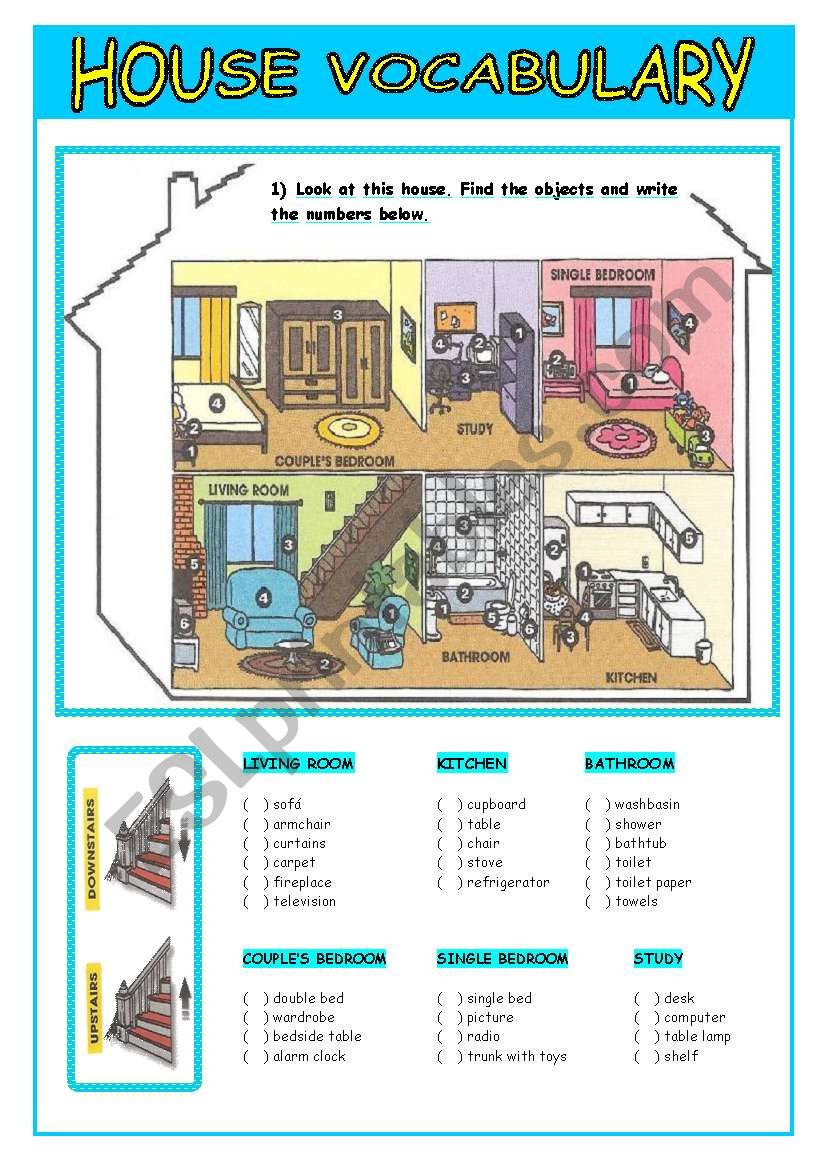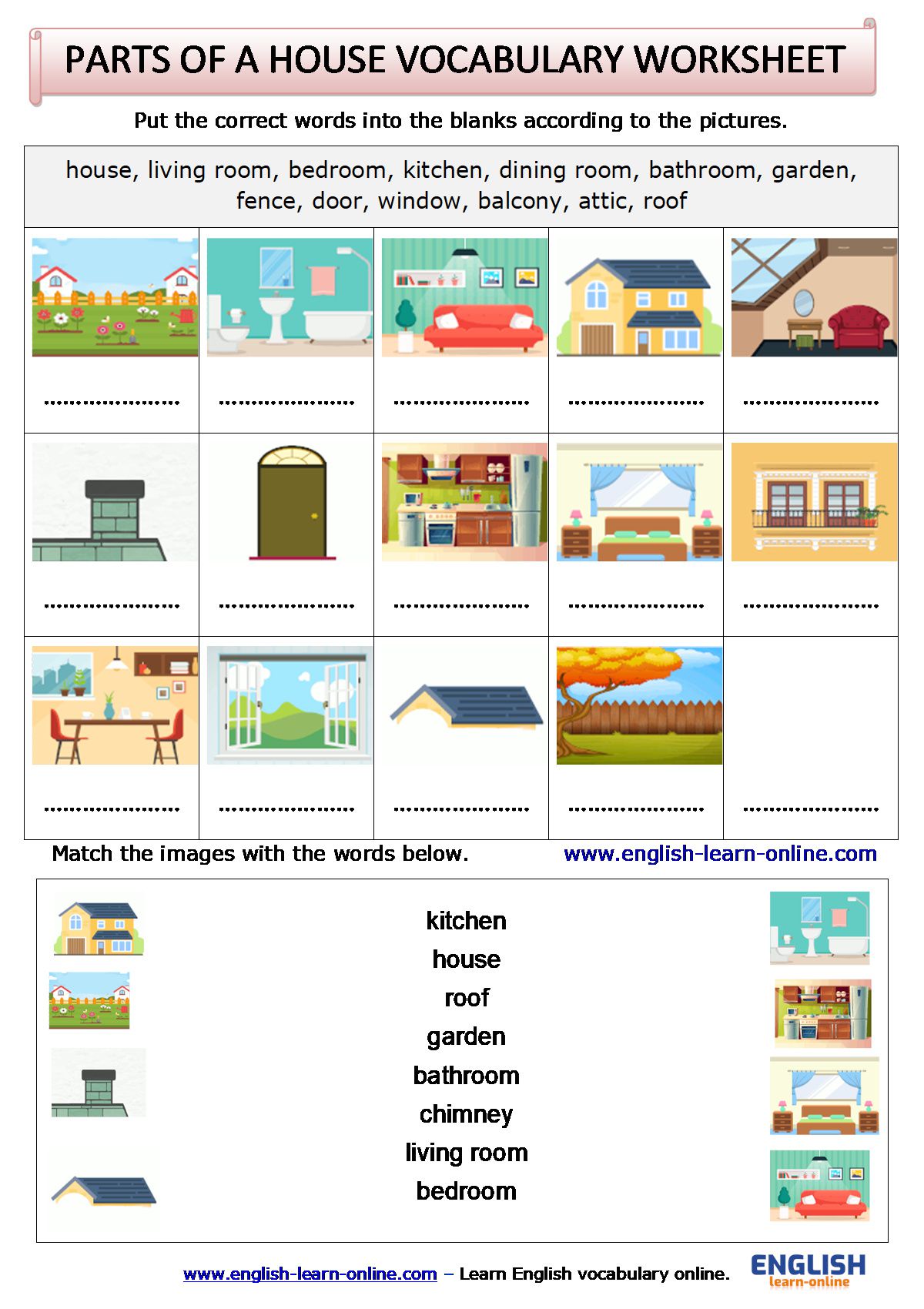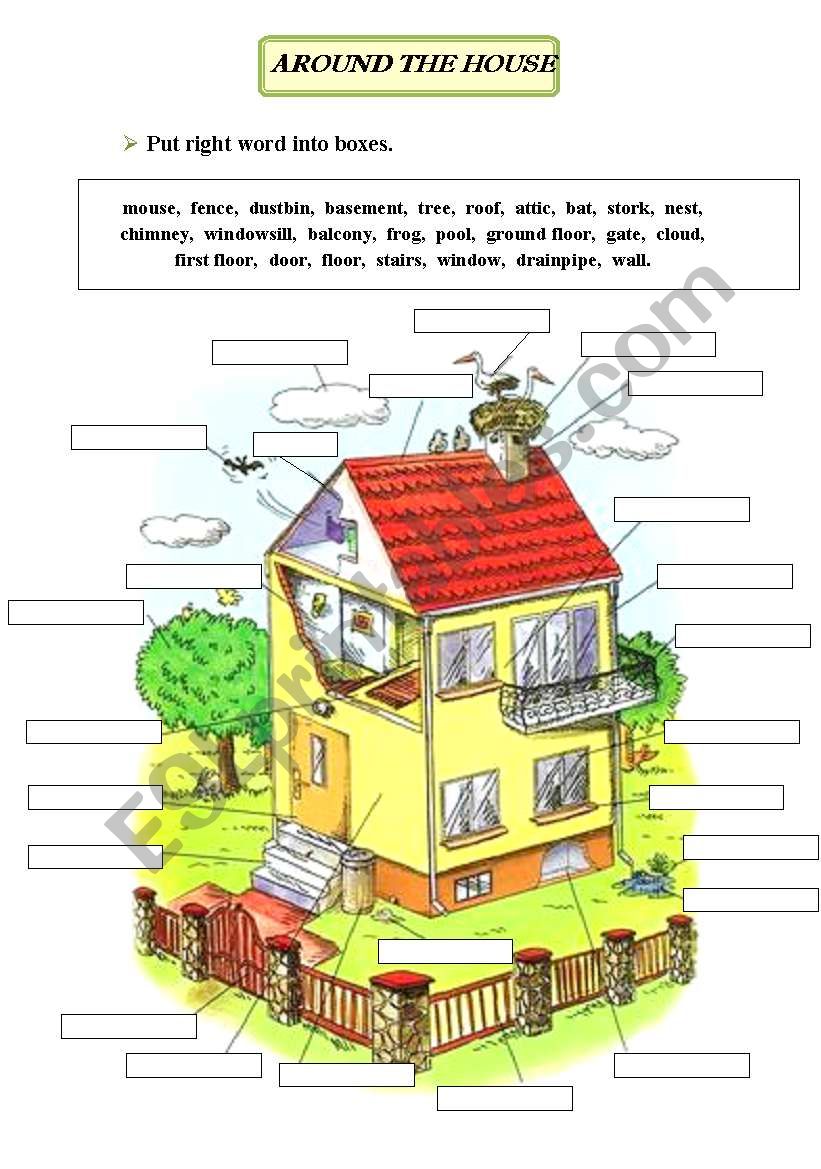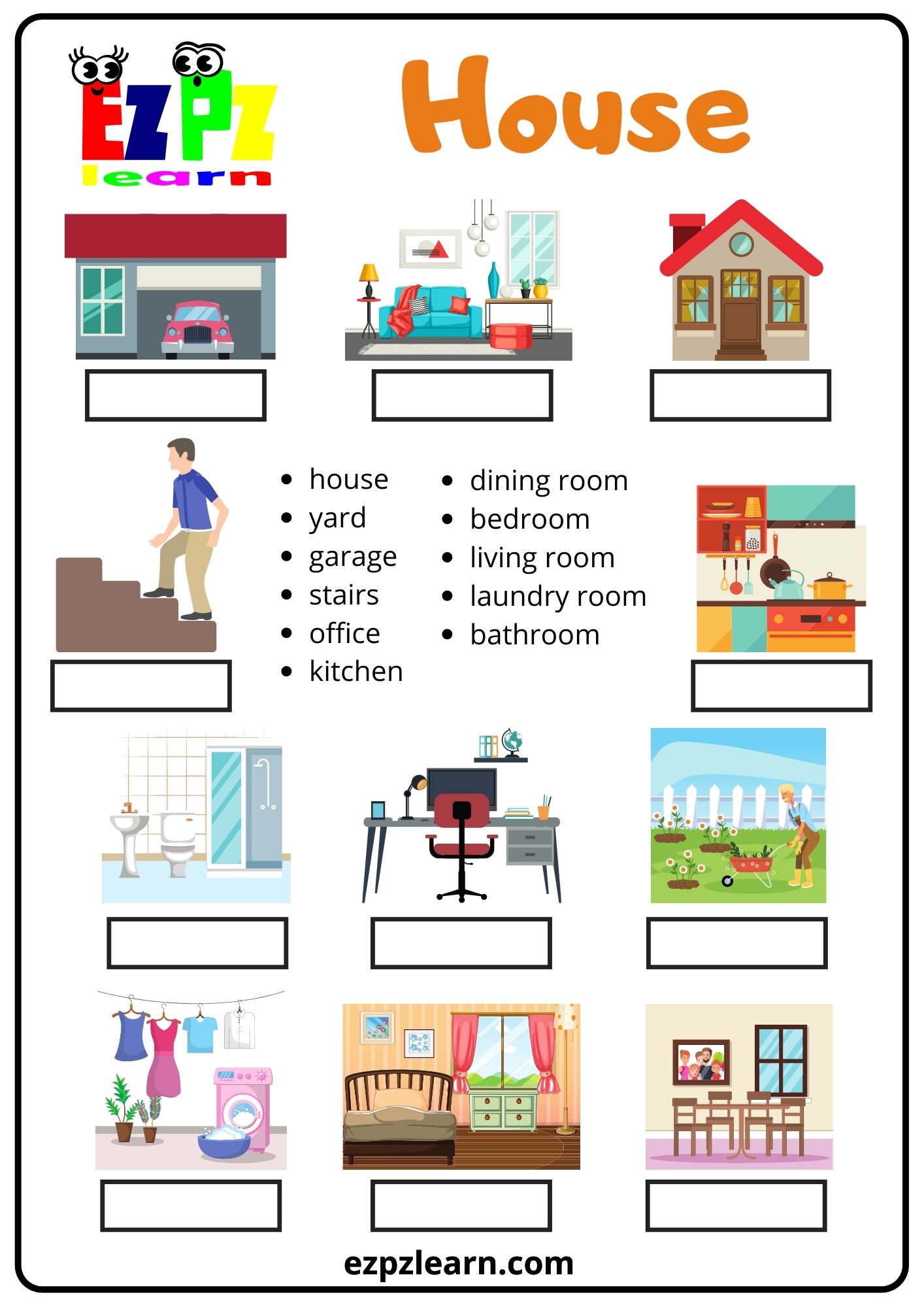
The Foundation of Fluent Living: Unlocking Language with House Vocabulary Worksheets
In the grand tapestry of language learning, acquiring vocabulary is akin to gathering the threads – each word a vital component that, when woven together, forms the fabric of communication. While abstract concepts and specialized jargon certainly have their place, the most immediate and impactful vocabulary for any language learner often revolves around the mundane, the everyday, the utterly practical. And what could be more practical, more central to daily life, than the home? This is where house vocabulary worksheets emerge as an indispensable tool, offering a structured, engaging, and highly effective pathway to mastering the words that describe our living spaces.
For individuals navigating a new language, whether they are young children just beginning their linguistic journey, adult immigrants settling into a new country, or dedicated ESL/EFL students aiming for fluency, understanding and utilizing terms related to the house is not just an academic exercise; it’s a fundamental step towards independence and integration. It empowers them to describe their surroundings, ask for specific items, understand directions, engage in casual conversation, and ultimately, feel more at home in their new linguistic environment.
Why House Vocabulary Matters So Profoundly

The home is a universal concept, yet the words we use to describe it are incredibly language-specific. Mastering house vocabulary provides several critical benefits:

- Immediate Practicality: From identifying the "kitchen" to asking for a "towel" in the "bathroom," these words are used countless times every day. Their acquisition leads to immediate, tangible improvements in communication.
- Relatability: Everyone lives somewhere. The objects and rooms within a house are tangible, making them easier to visualize and connect with the new vocabulary, regardless of the learner’s background.
- Foundation for Description: Once learners know the nouns (e.g., "sofa," "lamp," "window"), they can start adding adjectives (e.g., "comfortable sofa," "bright lamp," "large window") and verbs (e.g., "sit on the sofa," "turn on the lamp," "look out the window"), building more complex and nuanced sentences.
- Cultural Insight: Homes often reflect cultural norms and differences. Learning the vocabulary can open doors to discussions about housing styles, household chores, and family life in the target culture.
- Confidence Building: Successfully naming objects and rooms in a new language boosts a learner’s confidence, encouraging them to take on more challenging linguistic tasks.



The Unmatched Efficacy of Worksheets in Vocabulary Acquisition

While immersion and direct conversation are powerful, they often benefit from structured support. This is where house vocabulary worksheets shine. Worksheets offer:
- Active Engagement: Unlike passive listening, worksheets demand active participation, requiring learners to retrieve, process, and apply the new words.
- Reinforcement and Repetition: They provide multiple opportunities to encounter and practice the same vocabulary in different contexts, solidifying memory.
- Visual Support: Many house vocabulary worksheets incorporate images, which are incredibly effective for visual learners and for creating strong associations between the word and the object.
- Self-Paced Learning: Learners can work through worksheets at their own speed, focusing more on challenging areas and moving quickly through familiar ones.
- Measurable Progress: Completing worksheets offers a tangible sense of accomplishment and allows both learners and educators to track progress.
- Versatility: Worksheets can be adapted for various learning styles and proficiency levels, from simple matching exercises for beginners to complex descriptive tasks for advanced learners.



A Spectrum of Engaging House Vocabulary Worksheets
The beauty of worksheets lies in their adaptability. There’s no single "best" type; rather, a variety of formats caters to different learning preferences and target skills. Here are some of the most effective types of house vocabulary worksheets:
-
Picture Matching Worksheets:
- Concept: Learners match an image of a room or an object within a house to its corresponding word in the target language.
- Why it works: Excellent for beginners, reinforcing visual-word association. It’s intuitive and requires minimal prior knowledge.
- Example: A picture of a bed next to the word "bed" or "kamar tidur."
-
Labeling Diagrams:
- Concept: A detailed drawing of a house, a specific room (e.g., a kitchen), or a piece of furniture (e.g., a dresser) with blank lines pointing to various components. Learners write the correct vocabulary word on each line.
- Why it works: Develops spatial awareness and precise vocabulary. It’s highly visual and contextual.
- Example: A diagram of a living room with arrows pointing to the sofa, coffee table, television, and rug.
-
Fill-in-the-Blanks:
- Concept: Sentences or short paragraphs describing a house or activities within it, with key vocabulary words omitted. Learners fill in the blanks using a word bank or from memory.
- Why it works: Encourages contextual understanding and grammatical application of the vocabulary.
- Example: "I cook dinner in the __." (kitchen) or "You usually sleep in the __." (bedroom).
-
Word Searches and Crosswords:
- Concept: Classic puzzles where learners find hidden house-related words in a grid or fill in a grid based on clues.
- Why it works: Fun and engaging, these puzzles reinforce spelling and word recognition in a low-pressure environment. They are also excellent for review.
- Example: A crossword clue might be "A place where you take a shower (7 letters)" leading to "bathroom."
-
Categorization Worksheets:
- Concept: Learners are given a list of house-related words and must sort them into categories (e.g., "Kitchen Items," "Bathroom Items," "Furniture," "Rooms").
- Why it works: Helps learners organize vocabulary semantically, making it easier to recall and use in context. Develops logical thinking.
- Example: List includes "sink," "oven," "toilet," "bathtub," "sofa," "chair." Categories are "Kitchen," "Bathroom," "Living Room."
-
Sentence Building/Descriptive Worksheets:
- Concept: Learners use a given set of house vocabulary words to construct their own sentences, describe a room, or even write a short paragraph about their dream home.
- Why it works: Moves beyond simple recognition to active production, encouraging creativity and more complex language use.
- Example: "Use the words ‘window,’ ‘curtains,’ and ‘bright’ to describe your bedroom."
-
True/False or Multiple Choice:
- Concept: Statements about a house or objects within it, where learners decide if the statement is true or false, or choose the best option from a list.
- Why it works: Good for quick assessment and reinforcing understanding of definitions and functions.
- Example: "A refrigerator is usually found in the bathroom. (True/False)"
-
"What’s Missing?" Worksheets:
- Concept: A picture of a room is presented, and learners list items that are typically found there but are not shown in the picture, or vice versa.
- Why it works: Encourages active recall and expands vocabulary beyond what is explicitly provided.
Implementing House Vocabulary Worksheets Effectively
To maximize the impact of house vocabulary worksheets, consider these strategies:
- Integrate with Realia: Whenever possible, bring real objects into the classroom (or point them out at home) as you introduce the vocabulary. This creates a tangible connection.
- Contextualize: Don’t just teach isolated words. Use them in sentences, create mini-dialogues, or describe scenarios where the words would be used naturally.
- Encourage Pronunciation Practice: After completing a worksheet, have learners read the words aloud, paying attention to correct pronunciation and intonation.
- Review and Recycle: Vocabulary needs repeated exposure. Revisit previously learned house vocabulary through games, quick quizzes, or by incorporating it into new activities.
- Personalize: Ask learners to describe their own homes using the new vocabulary. This makes the learning highly relevant and memorable.
- Pair Work/Group Work: Many worksheets can be adapted for collaborative learning, allowing students to teach each other and practice communication.
Creating Your Own House Vocabulary Worksheets
While countless resources for pre-made worksheets exist online, designing your own allows for tailoring to specific learner needs and interests. Here’s a basic process:
- Define Your Target Vocabulary: Select 10-20 words relevant to a specific room or aspect of the house (e.g., "Living Room Furniture," "Kitchen Appliances").
- Choose Activity Types: Decide which worksheet formats (matching, fill-in-the-blank, labeling) best suit your learners’ level and the vocabulary you’re teaching.
- Incorporate Visuals: Use clear, engaging images. Simple clip art or photographs work well.
- Keep it Clear and Concise: Instructions should be easy to understand. Layout should be clean and uncluttered.
- Provide an Answer Key: This is crucial for self-correction and for teachers to quickly check work.
- Differentiate: Consider creating slightly easier and slightly harder versions of the same worksheet to cater to varying proficiency levels within a group.
- Utilize Online Tools: Websites like Canva, Quizlet, or even simple word processors can help you design professional-looking worksheets.
Beyond the Worksheet: Extending Learning
While worksheets are powerful, they are just one piece of the puzzle. To truly embed house vocabulary, encourage learners to:
- Label items at home: Use sticky notes to label objects in their own environment.
- Take virtual house tours: Explore real estate websites or architectural design sites in the target language.
- Describe pictures: Have them describe photos of different houses or rooms.
- Play "I Spy": A classic game that reinforces object recognition and vocabulary.
- Watch home improvement shows: These are rich sources of practical vocabulary and contextual use.
Conclusion
The journey to language fluency is paved with consistent effort and strategic resource utilization. Among the myriad tools available, house vocabulary worksheets stand out as exceptionally effective, providing a structured, engaging, and highly practical means for learners of all ages and levels to master the essential words describing their living spaces. By integrating these versatile tools into a comprehensive language learning approach, educators and learners alike can build a strong foundation, fostering confidence and enabling truly fluent living within any linguistic landscape. From the humble "door" to the complex "architectural design," the vocabulary of the home is the bedrock upon which meaningful communication is built.
